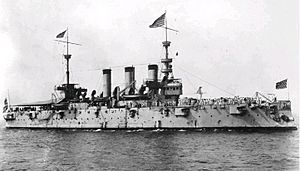Battle of the Aguadores facts for kids
Quick facts for kids Battle of the Aguadores |
|||||||
|---|---|---|---|---|---|---|---|
| Part of the Spanish–American War | |||||||
 USS New York, circa 1898 |
|||||||
|
|||||||
| Belligerents | |||||||
| Commanders and leaders | |||||||
| Strength | |||||||
| 274 | 2,700 1 armoured cruiser 2 gunboats |
||||||
| Casualties and losses | |||||||
| None | 10 killed & wounded | ||||||
The Battle of the Aguadores was a small but important fight. It happened on July 1, 1898, near the Aguadores River in Santiago de Cuba, Cuba. This was during the Spanish–American War.
American forces attacked to trick the Spanish. They wanted to make the Spanish move soldiers away from San Juan Hill and El Caney. These were the main battle areas that day.
However, the American attack did not go as planned. The US Army and Navy did not work well together. The Navy's bombs did not hit the Spanish soldiers. When the American soldiers arrived, the main bridge was broken. The river was too hard to cross.
About 700 soldiers from the 33rd Michigan Regiment tried to attack. But they could not get close to the Spanish. Spanish rifle fire stopped them at the river. The American commander, Henry Duffield, saw his men getting hurt. He stopped the attack and pulled his troops back.
The Spanish did not move any soldiers from Santiago. The US Secretary of the Army said the attack helped. He thought it stopped the Spanish from sending help to San Juan Heights. But there was no proof of this.
What Happened During the Battle?
Moving soldiers in the thick jungle was hard. The 33rd Michigan National Guard had to use a train twice. They got within 1 kilometer (about 0.6 miles) of the river. The whole group could not fit on the train at once.
This train noise in the early morning warned the Spanish. They knew an attack was coming.
The battle started with a naval attack. A small group of US Navy ships fired their artillery from the coast. At 9:00 AM, the armored ship USS New York began shooting. Two smaller ships, USS Suwanee and Gloucester, joined in.
One lucky shot from the Suwanee hit the Spanish flag. It was flying over a small fort. But the Navy's bombs did not do much damage. The ships could not aim well at the Spanish rifle pits. They also could not hit the strong houses on top of the hills. Spanish soldiers stayed safe in their positions. They waited for the naval gunfire to stop.
Ground Battle and Retreat
Spanish soldiers fired back with modern Mauser rifles. They also used their own artillery. Their shots hit the American soldiers who were trying to advance. The Americans stopped on the east bank of the river. Their goal was to reach the railroad bridge. This bridge was near the Morro batteries.
The American soldiers used .45/70 Trapdoor Springfields. These guns made a lot of smoke when fired. This smoke showed the Spanish where the Americans were hiding. The Spanish had an advantage. Their weapons used smokeless powder.
Brigadier General Duffield kept firing for most of the afternoon. But his men could not move forward. He also did not know if his attack had helped the main battles. So, he told his men to stop fighting at 1:30 PM.
The soldiers had gotten their food and bullets at 1:30 AM. They had been moving or fighting in the thick jungle for many hours. The first to leave were the wounded soldiers. They were put on the first train out.

